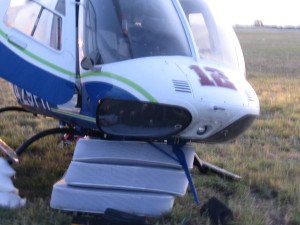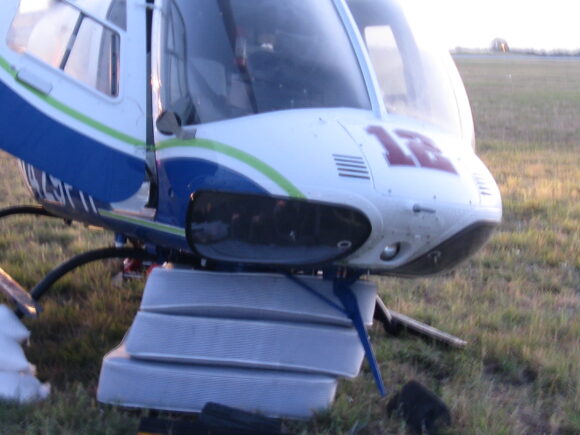The safety of helicopter ambulances is under scrutiny after three crew members were killed in a crash in a wooded area of northern Wisconsin this week.
The National Transportation Safety Board is investigating, and the cause of the crash Thursday is not yet known. However, the conditions – late at night in a remote rural area – make it “the classic case” of a crash involving a medical helicopter, said Kevin Durkin, an aviation lawyer in Chicago.
MEDICAL HELICOPTER CRASHES
From 1990 through 2015, 217 people died in 81 fatal accidents involving medical helicopters, according to the NTSB. The worst year was 2008, when 28 people died.
There were 220 accidents, including those without fatalities, during the 1990-2015 period. There were at least 10 crashes every year from 1999 through 2008, as the use of helicopters to ferry patients grew.
HELICOPTER NUMBERS
There are about 10,600 helicopters of all types operating in the U.S., according to a group made up of government and helicopter industry representatives. In 2017, there were about 3.5 crashes for every 100,000 hours of flying, roughly the same as the year before but down from nearly 5.0 per 100,000 hours in 2013 and 4.3 in 2014.

In recent years, helicopters overall have had a lower rate of fatal accidents than small planes for the same amount of flying, according to figures from the Federal Aviation Administration.
“Generally it is very safe,” said Dan Sweet, a spokesman for the Helicopter Association International in Alexandria, Virginia. “It’s safer than automobiles, but automobile crashes don’t have the same news value.”
BIGGER IS SAFER
However, helicopters and small planes are far more likely to crash than bigger planes. US airliners had not suffered a single passenger death due to an accident from 2009 until this month, when an engine explosion on a Southwest Airlines jet killed a passenger.
Helicopters do more takeoffs and landings – the most dangerous parts of flight – than most planes. Most have only a single engine, so a mechanical problem can quickly turn deadly. They land on many kinds of surfaces, not just runways, and fly at lower altitudes, exposing them to dangerous obstacles including power lines, buildings and mountains. Weather may also be a factor, especially for air ambulances.
When the weather is bad, hospitals will call several air ambulances until they find a pilot willing to fly, said Ladd Sanger, an aviation lawyer in Dallas.
“There is pressure on the providers and the pilots to go because they want to be known as the guy that always goes and not the one that says no,” Sanger said.
HELICOPTER DESIGNS
Safety experts say more could be done to make the aircraft safer, including expanding a requirement on new helicopters to have fire-resistant fuel tanks.
In just one case, a flight nurse who was badly burned in the crash of a medical helicopter in Colorado reached a settlement this year with Airbus Helicopters and Air Methods Corp. for $100 million, according to the nurse’s lawyers. The pilot was killed – his daughters reached a settlement of undisclosed terms with Airbus Helicopters – and another nurse injured. Investigators believed that the crash was survivable, but the helicopter did not have a crash-resistant fuel system.
Durkin said he faults the manufacturers, the helicopter operators and the FAA for not requiring more helicopters to have safer fuel systems.
PILOT TRAINING
Most helicopter pilots learn the craft at a flight school or in the military. The requirements are similar for flying airplanes, and it’s possible to get a private operator’s certificate after 40 hours of flying time. Commercial helicopter pilots, however, have far more time in the air.
“EMS pilots generally are very experienced,” Sweet said. He said operators frequently demand at least 1,500 flight hours before considering an applicant.
UNNECESSARY TRIPS?
A ride in an air ambulance can be very expensive, and critics say they have become far too common.
“They can be very good tools for people that are injured or sick in remote areas to get to the hospital,” said Sanger, the aviation lawyer. “The vast, vast majority of helicopter transports are not medically necessary. You would get to the hospital faster and way cheaper if you used a ground ambulance.”
Was this article valuable?
Here are more articles you may enjoy.


 California Bill Would Require Insurer Claims Handling Plans, And Double Penalties
California Bill Would Require Insurer Claims Handling Plans, And Double Penalties  Billionaire NFL Owner Suing Over Billboards Near His SoFi Stadium
Billionaire NFL Owner Suing Over Billboards Near His SoFi Stadium  Storm Goretti Batters Europe With Violent Winds, Power Cuts
Storm Goretti Batters Europe With Violent Winds, Power Cuts  Musk’s xAI Faces California AG Probe Over Grok Sexual Images
Musk’s xAI Faces California AG Probe Over Grok Sexual Images 